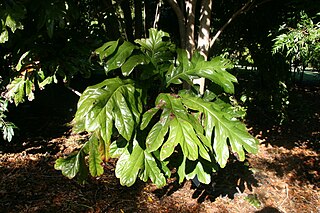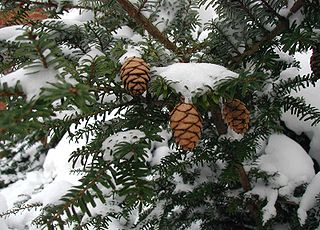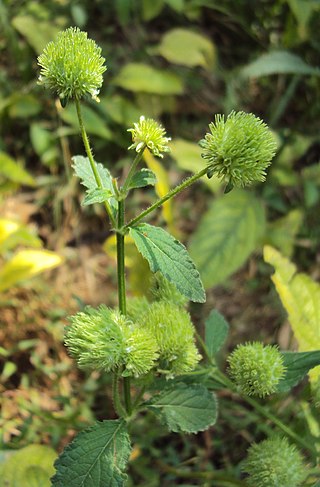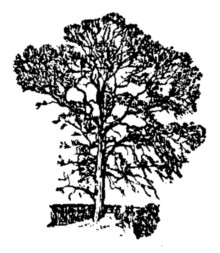
Garcinia is a genus of flowering plants in the family Clusiaceae native to Asia, America, Australia, tropical and southern Africa, and Polynesia. The number of species is disputed; Plants of the World Online (POWO) recognise up to 400. Commonly, the plants in this genus are called saptrees, mangosteens, or garcinias, and is one of several plants known as by the name "monkey fruit".

Coccoloba diversifolia, known as pigeonplum or tietongue, is a species of the genus Coccoloba native to coastal areas of the Caribbean, Central America, southern Mexico, southern Florida and the Bahamas.

Leucaena is a genus of flowering plants in the mimosoid clade of the subfamily Caesalpinioideae of the family Fabaceae. It contains about 24 species of trees and shrubs, which are commonly known as leadtrees. They are native to the Americas, ranging from Texas in the United States south to Peru. The generic name is derived from the Greek word λευκός (leukos), meaning "white," referring to the flowers.

Athertonia is a monotypic genus of plants in the family Proteaceae. The sole described species is Athertonia diversifolia, commonly known as Atherton oak, athertonia, creamy silky oak or white oak. It is endemic to a small part of the Wet Tropics of Queensland, Australia. A relative of the macadamia, it has potential in horticulture and the bushfood industry.

Tsuga diversifolia, commonly known as the northern Japanese hemlock, or in Japanese, kometsuga (米栂), is a species of conifer native to the Japanese islands of Honshū, Kyūshū, and Shikoku. In Europe and North America, the species is sometimes employed as tree for the garden and has been in cultivation since 1861.
Pulicaria diversifolia is a species of flowering plant in the family Asteraceae.It is found only in Yemen. Its natural habitat is rocky areas.
Garcinia diversifolia is a species of flowering plant in the family Clusiaceae. It is a tree endemic to Peninsular Malaysia.
Mesosphaerum argutifolium is a species of flowering plant in the family Lamiaceae, formerly known as Hyptis argutifolia. It is found only in Ecuador. Its natural habitat is subtropical or tropical moist montane forests.

Hyptis is a genus of flowering plant in the family Lamiaceae. These plants, known commonly as bushmints, are widespread in tropical North and South America, as well as parts of West Africa. There are 150 species, which may be annual or perennial herb to shrub. Recently, several genera were segregated from Hyptis.
Hyptis florida is a species of flowering plant in the family Lamiaceae. It is found only in Ecuador. Its natural habitat is subtropical or tropical moist lowland forests.
Mesosphaerum pseudoglaucum is a species of flowering plant in the family Lamiaceae, formerly known as Hyptis pseudoglauca. It is found only in Ecuador. Its natural habitat is subtropical or tropical moist montane forests.

Condea emoryi, the desert lavender, is a large, multi-stemmed shrub species of flowering plant in Lamiaceae, the mint family.

Hyptis alata, the musky mint or clustered bushmint, is a shrub species of flowering plant in the Lamiaceae, the mint family. The genus Hyptis is commonly known as the bushmints. It is a native species throughout the southeastern United States from Texas to North Carolina, as well as in Cuba, Argentina, southern Brazil, and Paraguay. It is found in wetlands, prairies, pond margins and wet flatwoods. Hyptis alata is the southeastern United States analog to the Southwestern deserts H. emoryi, the desert lavender.USDA: NRCS: Plants Profile Hyptis alata
- Hyptis alata subsp. alata - United States and Cuba
- Hyptis alata subsp. rugosula(Briq.) Harley - South America

Comarostaphylis diversifolia, known by the common names summer holly and California comarostaphylos, is a species of shrub in the heath family.

Pyrausta phoenicealis, the perilla leaf moth, is a moth of the family Crambidae described by Jacob Hübner in 1818. It is found worldwide, including the Americas, Africa, Australia and Asia.
Nepean Bay Conservation Park is a protected area in the Australian state of South Australia on Kangaroo Island. It was dedicated in 1974 for the protection of flora and fauna, and is the only reserved area of coastal sandplain on the island.

Hyptis capitata, also known as false ironwort or knobweed, is a species of erect annual shrubs, of the plant family Lamiaceae. It is native to Florida, Mexico, Central America, the West Indies, and South America but naturalized in Australia, Southeast Asia, and some tropical islands. The plants grow up to a height of 1.5 meters. Crushed leaves are applied to cuts. It is considered a weed in many places.

Ulmus × diversifolia, also known as the diverse leaved elm, was originally described by Melville in 1939 as a new species, U. diversifolia, though he later believed it a natural hybrid of Coritanian elm, Plot elm and Wych elm. He recorded its distribution in Hertfordshire, between Hatfield, Hertford and Watton-at-Stone, and in Suffolk, where it was common along the coastal plain from Ipswich and Felixstowe to Lowestoft and Beccles, occurring inland as far as Diss and Debenham, and probably extending further north into Norfolk and south towards Colchester, Essex. He accordingly referred to it as "the East Anglian elm".

Eucalyptus diversifolia, commonly known as the soap mallee, coastal white mallee, South Australian coastal mallee, or coast gum is a species of mallee that is endemic to an area along the southern coast of Australia. It has smooth bark, lance-shaped adult leaves, flower buds in groups of between seven and eleven, white to creamy yellow flowers and cup-shaped fruit.

Hyptis brevipes is a species of flowering plant in the genus Hyptis. These plants known commonly as lesser roundweed, nanto-iganigakusa (Taiwan), genggeyan and kaneja (Indonesia), sawi hutan (Malaysia), ortela-brava and fazendeiro (Brazil). Hyptis brevipes is an erect annual plant up to 1 m high with the typical square stem of a labiate, often densely hairy but sometimes less so. Leaves are also normally coarsely hairy on both surfaces, opposite, narrowly ovate or lanceolate, 5–7 cm long, up to 2 cm wide, cuneate at the base, the margins irregularly serrate. The inflorescence is a dense raceme, almost globose, up to 14 mm diameter, on a peduncle about 1 cm long in the axils of most upper leaves. Corolla or petals are white, irregularly five-lobed, and about 5 mm long. The calyx, 4 mm long, also has five narrow, finely barbed lobes. Seeds are ovoid, up to 1 mm long, dark brown to black, obscurely striate, with a conspicuous scar.













